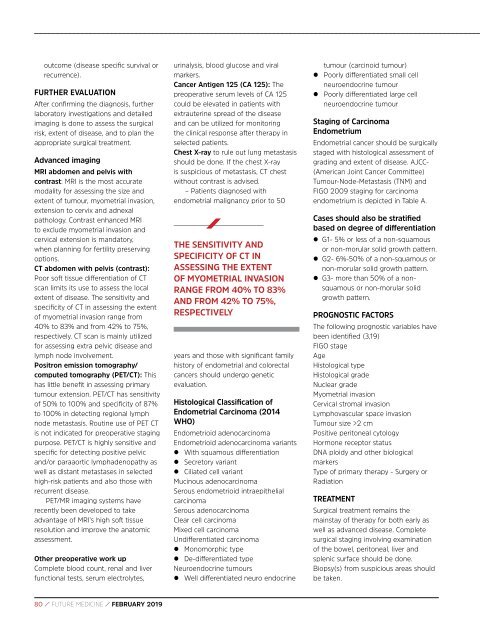Create successful ePaper yourself
Turn your PDF publications into a flip-book with our unique Google optimized e-Paper software.
outcome (disease specific survival or<br />
recurrence).<br />
FURTHER EVALUATION<br />
After confirming the diagnosis, further<br />
laboratory investigations and detailed<br />
imaging is done to assess the surgical<br />
risk, extent of disease, and to plan the<br />
appropriate surgical treatment.<br />
Advanced imaging<br />
MRI abdomen and pelvis with<br />
contrast: MRI is the most accurate<br />
modality for assessing the size and<br />
extent of tumour, myometrial invasion,<br />
extension to cervix and adnexal<br />
pathology. Contrast enhanced MRI<br />
to exclude myometrial invasion and<br />
cervical extension is mandatory,<br />
when planning for fertility preserving<br />
options.<br />
CT abdomen with pelvis (contrast):<br />
Poor soft tissue differentiation of CT<br />
scan limits its use to assess the local<br />
extent of disease. The sensitivity and<br />
specificity of CT in assessing the extent<br />
of myometrial invasion range from<br />
40% to 83% and from 42% to 75%,<br />
respectively. CT scan is mainly utilized<br />
for assessing extra pelvic disease and<br />
lymph node involvement.<br />
Positron emission tomography/<br />
computed tomography (PET/CT): This<br />
has little benefit in assessing primary<br />
tumour extension. PET/CT has sensitivity<br />
of 50% to 100% and specificity of 87%<br />
to 100% in detecting regional lymph<br />
node metastasis. Routine use of PET CT<br />
is not indicated for preoperative staging<br />
purpose. PET/CT is highly sensitive and<br />
specific for detecting positive pelvic<br />
and/or paraaortic lymphadenopathy as<br />
well as distant metastases in selected<br />
high-risk patients and also those with<br />
recurrent disease.<br />
PET/MR imaging systems have<br />
recently been developed to take<br />
advantage of MRI’s high soft tissue<br />
resolution and improve the anatomic<br />
assessment.<br />
Other preoperative work up<br />
Complete blood count, renal and liver<br />
functional tests, serum electrolytes,<br />
urinalysis, blood glucose and viral<br />
markers.<br />
Cancer Antigen 125 (CA 125): The<br />
preoperative serum levels of CA 125<br />
could be elevated in patients with<br />
extrauterine spread of the disease<br />
and can be utilized for monitoring<br />
the clinical response after therapy in<br />
selected patients.<br />
Chest X-ray to rule out lung metastasis<br />
should be done. If the chest X-ray<br />
is suspicious of metastasis, CT chest<br />
without contrast is advised.<br />
– Patients diagnosed with<br />
endometrial malignancy prior to 50<br />
THE SENSITIVITY AND<br />
SPECIFICITY OF CT IN<br />
ASSESSING THE EXTENT<br />
OF MYOMETRIAL INVASION<br />
RANGE FROM 40% TO 83%<br />
AND FROM 42% TO 75%,<br />
RESPECTIVELY<br />
years and those with significant family<br />
history of endometrial and colorectal<br />
cancers should undergo genetic<br />
evaluation.<br />
Histological Classification of<br />
Endometrial Carcinoma (2014<br />
WHO)<br />
Endometrioid adenocarcinoma<br />
Endometrioid adenocarcinoma variants<br />
• With squamous differentiation<br />
• Secretory variant<br />
• Ciliated cell variant<br />
Mucinous adenocarcinoma<br />
Serous endometrioid intraepithelial<br />
carcinoma<br />
Serous adenocarcinoma<br />
Clear cell carcinoma<br />
Mixed cell carcinoma<br />
Undifferentiated carcinoma<br />
• Monomorphic type<br />
• De-differentiated type<br />
Neuroendocrine tumours<br />
• Well differentiated neuro endocrine<br />
tumour (carcinoid tumour)<br />
• Poorly differentiated small cell<br />
neuroendocrine tumour<br />
• Poorly differentiated large cell<br />
neuroendocrine tumour<br />
Staging of Carcinoma<br />
Endometrium<br />
Endometrial cancer should be surgically<br />
staged with histological assessment of<br />
grading and extent of disease. AJCC-<br />
(American Joint Cancer Committee)<br />
Tumour-Node-Metastasis (TNM) and<br />
FIGO 2009 staging for carcinoma<br />
endometrium is depicted in Table A.<br />
Cases should also be stratified<br />
based on degree of differentiation<br />
• G1- 5% or less of a non-squamous<br />
or non-morular solid growth pattern.<br />
• G2- 6%-50% of a non-squamous or<br />
non-morular solid growth pattern.<br />
• G3- more than 50% of a nonsquamous<br />
or non-morular solid<br />
growth pattern.<br />
PROGNOSTIC FACTORS<br />
The following prognostic variables have<br />
been identified (3,19)<br />
FIGO stage<br />
Age<br />
Histological type<br />
Histological grade<br />
Nuclear grade<br />
Myometrial invasion<br />
Cervical stromal invasion<br />
Lymphovascular space invasion<br />
Tumour size >2 cm<br />
Positive peritoneal cytology<br />
Hormone receptor status<br />
DNA ploidy and other biological<br />
markers<br />
Type of primary therapy - Surgery or<br />
Radiation<br />
TREATMENT<br />
Surgical treatment remains the<br />
mainstay of therapy for both early as<br />
well as advanced disease. Complete<br />
surgical staging involving examination<br />
of the bowel, peritoneal, liver and<br />
splenic surface should be done.<br />
Biopsy(s) from suspicious areas should<br />
be taken.<br />
80 / FUTURE MEDICINE / <strong>FEBRUARY</strong> <strong>2019</strong>


















